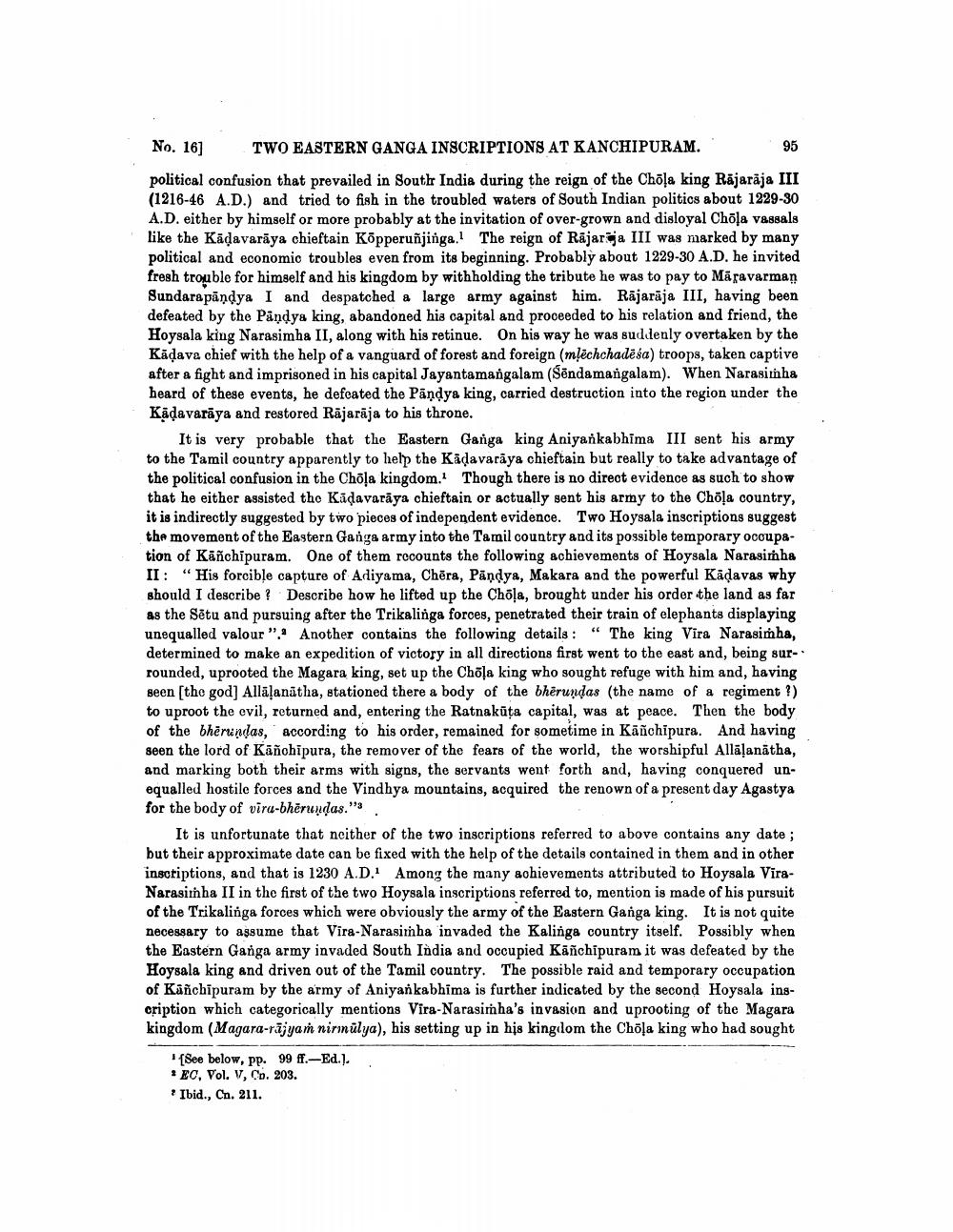________________
No. 161
TWO EASTERN GANGA INSCRIPTIONS AT KANCHIPURAM.
political confusion that prevailed in South India during the reign of the Chāļa king Rājarāja III (1216-46 A.D.) and tried to fish in the troubled waters of South Indian politics about 1229-30 A.D. either by himself or more probably at the invitation of over-grown and disloyal Chola vagsals like the Kādavarāya chieftain Kõpperuñjinga. The reign of Rājar ja III was marked by many political and economic troubles even from its beginning. Probably about 1229-30 A.D. he invited fresh trouble for himself and his kingdom by withholding the tribute he was to pay to Māravarman Sundarapāņdya I and despatched a large army against him. Rājarāja III, having been defeated by the Pandya king, abandoned his capital and proceeded to his relation and friend, the Hoysala king Narasimha II, along with his retinue. On his way he was suddenly overtaken by the Kādava chief with the help of a vanguard of forest and foreign (mļēchchadēša) troops, taken captive after a fight and imprisoned in his capital Jayantamangalam (Šēndamangalam). When Narasimha heard of these events, he defeated the Pandya king, carried destruction into the region under the Kādavarāya and restored Rājarāja to his throne.
It is very probable that the Eastern Ganga king Aniyankabhima III sent his army to the Tamil country apparently to help the Kādavarāya chieftain but really to take advantage of the political confusion in the Chola kingdom. Though there is no direct evidence as such to show that he either assisted the Kadavarāya chieftain or actually sent his army to the Chöļa country, it is indirectly suggested by two pieces of independent evidence. Two Hoysala inscriptions suggest the movement of the Eastern Ganga army into the Tamil country and its possible temporary occupation of Kanchipuram. One of them recounts the following achievements of Hoysala Narasimha II: "His forcible capture of Adiyama, Chēra, Pandya, Makara and the powerful Kādavas why should I describe ? Describe how he lifted up the Cho!a, brought under his order the land as far as the Sētu and pursuing after the Trikalinga forces, penetrated their train of elephants displaying unequalled valour". Another contains the following details : " The king Vira Narasimha, determined to make an expedition of victory in all directions first went to the east and, being surrounded, uprooted the Magara king, set up the Chõļa king who sought refuge with him and, having seen (the god) Allāļanátha, stationed there a body of the bhērundas (the name of a regiment ?) to uproot the evil, returned and, entering the Ratnakūţa capital, was at peace. Then the body of the bhērundas, according to his order, remained for sometime in Kanchipura. And having seen the lord of Kanchipura, the remover of the fears of the world, the worshipful Allāļanátha, and marking both their arms with signs, the servants went forth and, having conquered unequalled hostile forces and the Vindhya mountains, acquired the renown of a present day Agastya for the body of viru-bherundas." .
It is unfortunate that neither of the two inscriptions referred to above contains any date ; but their approximate date can be fixed with the help of the details contained in them and in other inscriptions, and that is 1230 A.D. Among the many achievements attributed to Hoysala ViraNarasimha II in the first of the two Hoysala inscriptions referred to mention is made of his pursuit of the Trikalinga forces which were obviously the army of the Eastern Ganga king. It is not quite necessary to assume that Vira-Narasimha invaded the Kalinga country itself. Possibly when the Eastern Ganga army invaded South India and occupied Kāñchipuram it was defeated by the Hoysala king and driven out of the Tamil country. The possible raid and temporary occupation of Kanchipuram by the army of Aniyankabhima is further indicated by the second Hoysala inscription which categorically mentions Vira-Narasimha's invasion and uprooting of the Magara kingdom (Magara-rājyam nirmülya), his setting up in his kingilom the Choļa king who had sought
*{See below, pp. 99 ff.-Ed.). * EC, Vol. V, Co. 203. * Ibid., Cn. 211.




